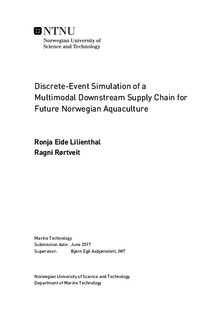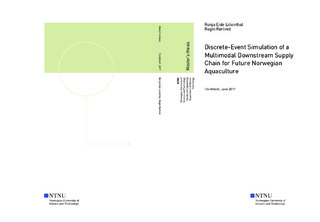| dc.description.abstract | The aim of this thesis is to model logistics for the downstream aquaculture supply chain interaction for increased production of salmon in the future. We employed a quantitative approach using discrete-event simulation, where we developed a model, replicating the real-world supply chain in MATLAB s add-on software Simulink. The output was basis for evaluations regarding system dynamics and flexibility, based on composition and throughput. Project limitations excluded human influence, as well as all commercial aspects, from the analyses.
The motivation for the thesis was the Norwegian governments goal to increase aquaculture production by five-fold within 2050. Following this increase comes the development of farm sizes and locations, as well as an adapted supply chain. Such an expansion may include the introduction of additional transportation modes, like processing vessels and seaborne transportation of products to market.
As a multimodal system, the challenge lies in coordinating the various modes, pursuing seamless integration between them. This is effectively assessed using discrete-event simulation, modelling the continuous movement of entities.
The model was run several times with different system compositions and scenarios. These served to verify the model, establish a benchmarking fleet and test system robustness against external influence. Two crash scenarios, simulating emergency slaughter and waiting cage ban, were imposed.
The results showed that delivery to market using the current day trucking system is efficient and reliable. However, a simulated expansion required a large fleet, which the introduction of cargo vessels could relieve. Processing vessels withheld transit-time to a minimum regardless of imposed scenarios, and were a contribution to continuity in operation.
In conclusion, we showed that any system upgrade must be supported by equivalent infrastructure to increase system performance. Collaboration and redundancy through parallel nodes were key factors in ensuring system up-time. Further work should include evaluations on commercial competitiveness. | |

